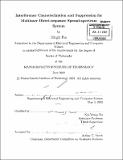| dc.contributor.advisor | Kai-Yeung Siu. | en_US |
| dc.contributor.author | Fan, Mingxi, 1975- | en_US |
| dc.contributor.other | Massachusetts Institute of Technology. Dept. of Electrical Engineering and Computer Science. | en_US |
| dc.date.accessioned | 2005-10-14T19:22:23Z | |
| dc.date.available | 2005-10-14T19:22:23Z | |
| dc.date.copyright | 2002 | en_US |
| dc.date.issued | 2002 | en_US |
| dc.identifier.uri | http://hdl.handle.net/1721.1/29238 | |
| dc.description | Thesis (Ph. D.)--Massachusetts Institute of Technology, Dept. of Electrical Engineering and Computer Science, 2002. | en_US |
| dc.description | Includes bibliographical references (p. 175-184). | en_US |
| dc.description.abstract | In this thesis we investigate efficient modulation and detection techniques for the uplink (i.e. transmission from mobile to base station) of a DS-CDMA network. Specifically, the thesis contains three parts. In the first part, we focus on the mobile transmitter. In particular, we evaluate and compare the spectral efficiency of two promising variable rate DS-CDMA transmission techniques, multicode (MCD) and variable-spreading-gain (VSG), under the presence of multiple-access (user-to-user) interferences (MAI) and multipath interferences. The uniqueness of our study is that in bit-error-rate evaluation, instead of approximating the interference as Gaussian noise (which has been done in most of the previous studies), we incorporate both power and distribution of interferences into consideration. We show where the Gaussian assumption may give misleading answers and how our results in these cases are different from those obtained in the past. In part two and three of the thesis, we focus on the base station receiver. Specifically, we present effective joint detection techniques that have good performance-complexity tradeoff. Part two of the thesis introduces a class of novel multistage parallel interference cancellation algorithms based on stage-by-stage minimum mean-squared error (MMSE) optimization. We show that this scheme is capable of achieving significantly better performance than other algorithms with similar complexity. Part three of the thesis presents a low-complexity dual-mode multiuser detector that dynamically switches its detection mode between the matched-filter receiver and the decorrelator. We show that this detector is capable of achieving the performance of a decorrelator but with significant savings in processing power and complexity. | en_US |
| dc.description.statementofresponsibility | by Mingxi Fan. | en_US |
| dc.format.extent | 184 p. | en_US |
| dc.format.extent | 6539812 bytes | |
| dc.format.extent | 6539619 bytes | |
| dc.format.mimetype | application/pdf | |
| dc.format.mimetype | application/pdf | |
| dc.language.iso | eng | en_US |
| dc.publisher | Massachusetts Institute of Technology | en_US |
| dc.rights | M.I.T. theses are protected by copyright. They may be viewed from this source for any purpose, but reproduction or distribution in any format is prohibited without written permission. See provided URL for inquiries about permission. | en_US |
| dc.rights.uri | http://dspace.mit.edu/handle/1721.1/7582 | |
| dc.subject | Electrical Engineering and Computer Science. | en_US |
| dc.title | Interference characterization and suppression for multiuser direct-sequence spread-spectrum system | en_US |
| dc.type | Thesis | en_US |
| dc.description.degree | Ph.D. | en_US |
| dc.contributor.department | Massachusetts Institute of Technology. Department of Electrical Engineering and Computer Science | |
| dc.identifier.oclc | 51547789 | en_US |
